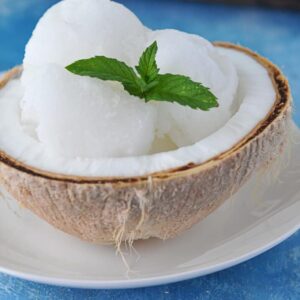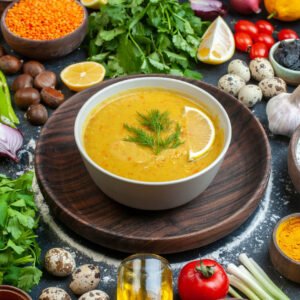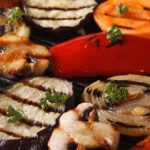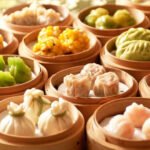Japanese food is famous for being fresh, healthy, and yummy. It uses simple ingredients like rice, fish, vegetables, and soy. Traditional Japanese meals taste great and often look beautiful on the plate. From sushi and sashimi to warm miso soup and hot pot, there are many tasty dishes to try. Eating Japanese food is a fun way to enjoy new flavors and learn about Japan’s culture.
Traditional Japanese Food: A Simple Guide to Japan’s Classic Meals
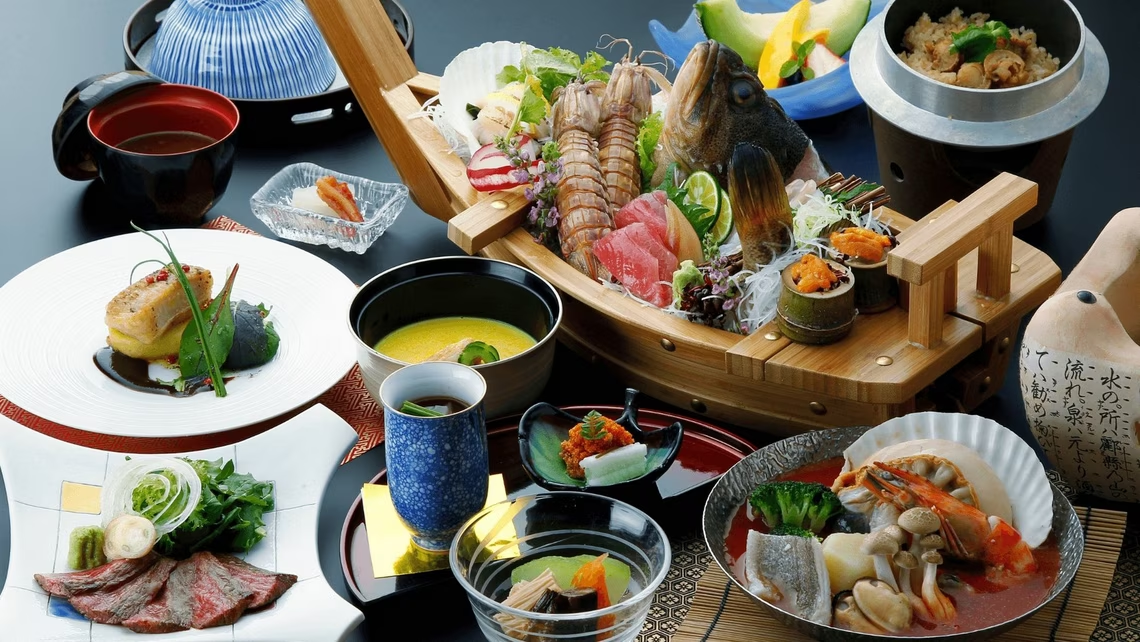
When you think of Japanese food, you might picture sushi or ramen. But there’s so much more to Japanese cooking! Traditional Japanese food, called “washoku”, is all about balance, fresh ingredients, and the beauty of nature. It’s healthy, tasty, and full of history.
What is Washoku?
Washoku means traditional Japanese food. It includes rice, fish, vegetables, soup, and pickles. The food is made with care and often changes with the seasons.
A typical meal includes:
-
Rice (Gohan) – A bowl of plain steamed rice
-
Soup (Shiru) – Usually miso soup with tofu and seaweed
-
Main Dish and Side Dishes (Okazu) – Often fish, tofu, or vegetables
-
Pickles (Tsukemono) – Small pieces of pickled veggies
This meal style is called “ichiju-sansai”, which means “one soup, three dishes.” It’s made to give you a healthy balance of flavors and nutrients.
Popular Traditional Japanese Dishes
Here are some famous traditional foods you should know:
Sushi & Sashimi Japan’s Most Famous Foods

Sushi and sashimi are two of the most well-known Japanese dishes. They both often use fresh fish, but they are quite different in how they are made and served.
What is Sushi?
Sushi is a dish made with special vinegared rice and usually topped or filled with other ingredients like raw fish, cooked seafood, vegetables, or even egg. Sushi comes in many different styles:
-
Nigiri – A small piece of rice with a slice of fish on top.
-
Maki – Sushi rolled in seaweed with rice, fish, or veggies inside.
-
Temaki – A cone-shaped roll you eat with your hands.
-
Inari – Rice stuffed in a sweet tofu pouch.
-
Soy sauce – for dipping
-
Wasabi – a green, spicy paste (use just a little!)
-
Pickled ginger – eaten between bites to clean your taste buds
Chefs arrange it carefully to look nice on the plate.
What is Sashimi?
Sashimi is thin slices of raw fish or seafood served without rice. It’s a simple dish that focuses on the fresh taste of the fish.
Popular sashimi types include:
-
Tuna (Maguro)
-
Salmon (Sake)
-
Shrimp (Ebi)
-
Octopus (Tako)
Sashimi is also served with soy sauce and a little wasabi. Sometimes it comes with shredded radish or seaweed on the side.
Fresh and Safe
Since both sushi and sashimi use raw fish, the fish must be very fresh and clean. Good restaurants make sure the fish is safe to eat and full of flavor. In Japan, many sushi chefs get their fish early in the morning from the market.
First Time Tips
If you’re trying sushi or sashimi for the first time:
-
Start with soft fish like salmon or shrimp
-
Don’t use too much soy sauce or wasabi
-
You can eat it with chopsticks or your hands—both are okay!
Sushi and sashimi are simple, fresh, and full of flavor. Whether you’re at a fancy restaurant or trying it from a takeout box, it’s a tasty way to experience Japanese food.
Miso Soup A Warm and Healthy Japanese Soup
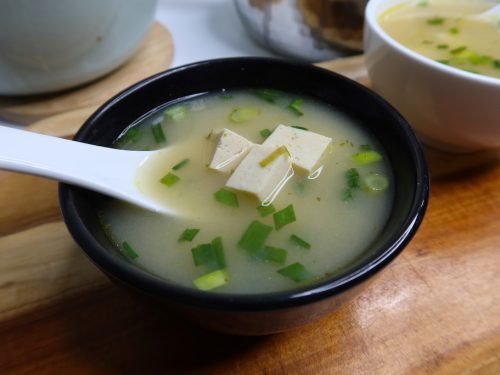
Miso soup is a soft, warm soup that is a big part of Japanese meals. People in Japan eat it almost every day — for breakfast, lunch, or dinner. It’s simple, healthy, and full of flavor.
What’s in Miso Soup?
The main ingredient is miso paste.
Miso paste is made from soybeans that are fermented, which means they are left to sit and change slowly over time. This gives the soup a rich, deep taste.
Miso soup usually includes:
-
Tofu – Soft, white cubes made from soybeans
-
Seaweed (Wakame) – A type of sea plant that becomes soft in hot soup
-
Green onions – Chopped and added for a light onion taste
-
Broth (Dashi) – A light soup base made from fish or seaweed
All of these mix together to make a warm and comforting soup.
Why Do People Love Miso Soup?
-
It’s healthy – low in calories and full of good nutrients
-
It’s easy to make – just a few ingredients
-
It’s good for your stomach – miso has good bacteria that help digestion
-
It goes well with rice, fish, or vegetables
Miso soup is a part of Japanese life. Every family may make it a little differently, and the ingredients can change with the seasons.
Different Types of Miso
There are a few kinds of miso paste, and they all taste a bit different:
-
White miso (shiro miso) – Light and slightly sweet
-
Red miso (aka miso) – Darker and stronger in flavor
-
Mixed miso (awase miso) – A mix of both white and red miso
Try It at Home – Simple Miso Soup Recipe
Here’s a super easy way to make miso soup:
You’ll need:
-
1 cup of water or broth (dashi)
-
1 tablespoon miso paste
-
A few tofu cubes
-
A pinch of dried seaweed (wakame)
-
A little chopped green onion (optional)
Steps:
-
Soak the seaweed in warm water to make it soft.
-
Heat the water or broth in a pot (don’t let it boil).
-
Stir in the miso paste until it fully mixes.
-
Add tofu and seaweed.
-
Top with green onions and enjoy!
Miso soup is simple, tasty, and full of tradition. It’s a great way to enjoy Japanese food at home, one warm bowl at a time.
Tempura Light and Crispy Japanese Fried Food
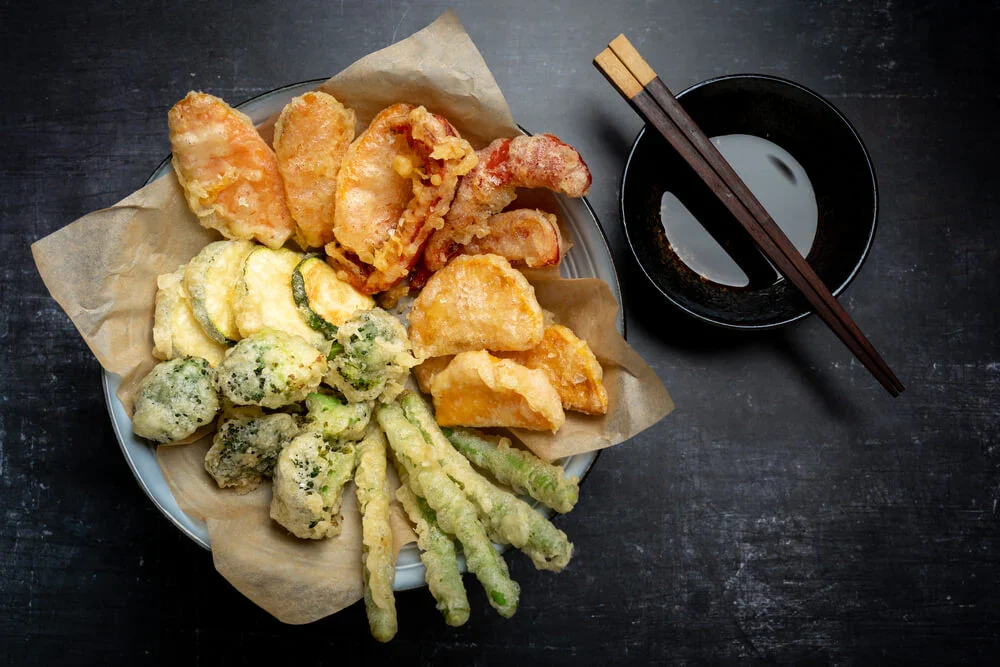
Tempura is a popular Japanese dish made by dipping seafood or vegetables in a light batter and frying them until they are crispy and golden. Even though it’s fried, tempura feels light and not too oily. It’s crunchy on the outside and soft inside — very tasty!
What Ingredients Are Used in Tempura?
You can make tempura with many different foods. The most common ones are:
Seafood:
-
Shrimp (called ebi in Japanese) – the most popular tempura
-
Fish – usually soft, white fish
-
Squid or scallops
Vegetables:
-
Sweet potato
-
Pumpkin
-
Carrot
-
Eggplant
-
Green beans
-
Bell pepper
The food is cut into small pieces, dipped in batter, and fried quickly so it stays fresh and tasty.
What Is Tempura Batter Made Of?
Tempura batter is very simple. It usually has:
-
Cold water
-
Flour
-
Egg (optional)
The batter is mixed gently and not for too long. This helps make the tempura light and crispy, not thick or heavy like other fried foods.
How is Tempura Served?
Tempura is usually eaten with a special dipping sauce called tentsuyu. This sauce is made from:
-
Soy sauce
-
Dashi (a light broth)
-
Mirin (sweet cooking wine)
Sometimes, grated white radish (daikon) is added to the sauce for extra flavor.
Tempura is often served with:
-
Rice
-
Noodles (like soba or udon)
You might also see tempura in:
-
Tendon – Tempura served on top of rice
-
Tempura Soba/Udon – Noodles served with tempura
-
Bento Boxes – Lunch boxes with rice, pickles, and tempura
-
Sushi Rolls – Some rolls have crispy tempura shrimp inside
A Little History
Did you know?
Tempura came from Portuguese people who came to Japan a long time ago. They taught the Japanese how to fry food in batter, and the Japanese turned it into their own unique style.
Want to Try Tempura at Home?
You can make simple tempura at home! Here are a few easy tips:
-
Keep the batter cold
-
Don’t mix the batter too much
-
Fry in hot oil (about 170–180°C / 340–360°F)
-
Place on paper towels after frying to keep it crispy
Tempura is fun, crispy, and easy to enjoy. Whether you like shrimp or vegetables, this famous Japanese food is always a good choice!
Bento A Tasty and Balanced Lunch Box
A bento is a special Japanese lunch box. It has different kinds of food all packed nicely together. Usually, a bento has:
-
Rice – plain or shaped into small balls
-
Meat or fish – like chicken, beef, or fish
-
Vegetables – cooked or fresh
-
Pickles – small pieces of sour or salty vegetables
Bentos are healthy and colorful. People take them to school, work, or on trips because they are easy to carry and have many kinds of food. Bentos are made to look nice and make eating fun.
Nabe (Hot Pot) A Warm Meal to Share
Nabe means “hot pot” in Japanese. It’s a big pot with tasty broth where you cook many ingredients together. It’s perfect to share with family or friends, especially on cold days.
Nabe usually has:
-
Tofu – soft soy cheese
-
Meat – thin slices of beef, pork, or chicken
-
Mushrooms – like shiitake or enoki
-
Vegetables – cabbage, carrots, green onions, and more
All the food cooks in the broth, making a warm and yummy soup. People eat the cooked food and drink the broth, sometimes with a dipping sauce.
Pickled Vegetables (Tsukemono) Small and Tasty Side Dishes
Tsukemono are small dishes of pickled vegetables. They taste sour or salty and add crunch to your meal.
Some common pickled veggies are:
-
Cucumber
-
Daikon radish
-
Cabbage
-
Eggplant
Pickled vegetables help clean your mouth between bites so you can enjoy all the flavors of your meal. They also help your digestion.
Summary
-
Bento is a colorful, healthy lunch box with rice, meat or fish, veggies, and pickles. It’s easy to carry and eat anywhere.
-
Nabe is a warm, shared hot pot with tofu, meat, mushrooms, and vegetables cooked in broth.
-
Tsukemono are small pickled vegetables that add flavor and help digestion.
Food That Follows the Seasons
Japanese food is closely connected to nature. People in Japan love to eat foods that are fresh and in season. For example, they eat cool noodles in the summer and hot pots in winter. The way food is served is also important. Dishes are arranged neatly, and the plates often match the season, like flowers in spring or leaves in fall.
Food in Japanese Culture
Food in Japan is more than just eating. It’s a big part of holidays, family time, and traditions. For example:
-
Mochi is eaten for New Year.
-
Soba noodles are eaten on New Year’s Eve.
-
Special snacks are made for cherry blossom viewing in spring.
Every meal is a way to show care and respect—for the food, the people, and nature.
FAQs
1. What are some popular Japanese foods?
Some well-known foods are sushi, sashimi, miso soup, tempura, bento, and ramen.
2. Is Japanese food healthy?
Yes! It uses fresh fish, rice, and vegetables that are good for you.
3. What is sushi?
Sushi is rice mixed with vinegar, often served with raw fish or other toppings.
4. What is miso soup?
Miso soup is a warm soup made from miso paste, tofu, seaweed, and green onions.
5. What is tempura?
Tempura is seafood or vegetables dipped in a light batter and fried until crispy.
6. What is a bento?
A bento is a lunch box with rice, meat or fish, vegetables, and pickles.
7. Do people in Japan eat raw fish?
Yes, raw fish like in sushi and sashimi is very popular.
8. What are tsukemono?
Tsukemono are small dishes of pickled vegetables that add flavor and help digestion.
9. Is Japanese food spicy?
Usually no. Japanese food is mild and focuses on fresh flavors.
10. Can I find Japanese food outside Japan?
Yes! Many countries have Japanese restaurants where you can try these foods.
Final Thoughts
Traditional Japanese food is simple, healthy, and full of meaning. It’s not just about taste, but also about balance, beauty, and culture. Whether you try sushi, miso soup, or a full bento box, you’re enjoying a part of Japan’s long and rich food tradition.
want to read more artical visit our website
Big Shoutout to the guys who made this blog happen UDM.

